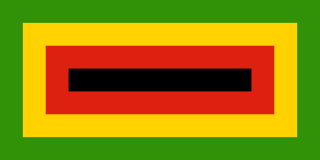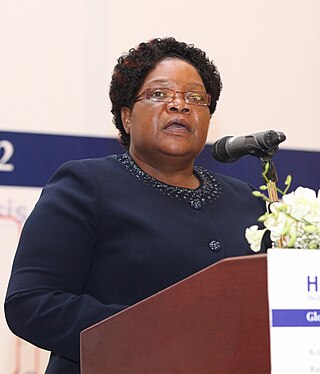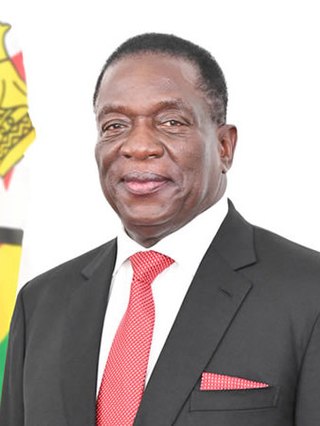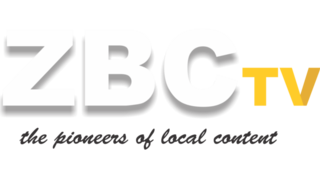Related Research Articles
Until roughly 2,000 years ago, what would become Zimbabwe was populated by ancestors of the San people. Bantu inhabitants of the region arrived and developed ceramic production in the area. A series of trading empires emerged, including the Kingdom of Mapungubwe and Kingdom of Zimbabwe. In the 1880s, the British South Africa Company began its activities in the region, leading to the colonial era in Southern Rhodesia.

Harare, formerly known as Salisbury, is the capital and largest city of Zimbabwe. The city proper has an area of 982.3 km2 (379.3 sq mi), a population of 1,849,600 as of the 2022 census and an estimated 2,487,209 people in its metropolitan province. The city is situated in north-eastern Zimbabwe in the country's Mashonaland region. Harare is a metropolitan province, which also incorporates the municipalities of Chitungwiza and Epworth. The city sits on a plateau at an elevation of 1,483 metres above sea level, and its climate falls into the subtropical highland category.
Communications in Zimbabwe refers to the communication services available in Zimbabwe.
Land reform in Zimbabwe officially began in 1980 with the signing of the Lancaster House Agreement, as a program to redistribute farmland from white Zimbabweans to black Zimbabweans as an effort by the ZANU-PF government to give more control over the country’s extensive farmlands to the black African majority. Before the implementation of these policies, the distribution of land in what was then known as Rhodesia saw a population of 4,400 white Rhodesians owning 51% of the country’s land while 4.3 million black Rhodesians owned 42%, with the remainder being non-agricultural land. The discrepancy of this distribution, as well as the overall dominance of the white population in the newly-independent but largely unrecognized Rhodesian state was challenged by the black nationalist organizations ZANU and ZAPU in the Rhodesian Bush War. At the establishment of the modern Zimbabwean state in 1980 after the bush war, the Lancaster House Agreement held a clause that prohibited forced transfer of land, this resulted in changes in land distribution from the willing sale or transfer by owners being minor until 2000, when the government of Robert Mugabe began a more aggressive policy.

The Zimbabwe African National Union – Patriotic Front (ZANU–PF) is a political organisation which has been the ruling party of Zimbabwe since independence in 1980. The party was led for many years by Robert Mugabe, first as prime minister with the Zimbabwe African National Union (ZANU) and then as president from 1987 after the merger with the Zimbabwe African People's Union (ZAPU) and retaining the name ZANU–PF, until 2017, when he was removed as leader.

Joshua Mqabuko Nyongolo Nkomo was a Zimbabwean revolutionary and politician who served as Vice-President of Zimbabwe from 1990 until his death in 1999. He founded and led the Zimbabwe African People's Union (ZAPU) from 1961 until it merged in 1987 with Robert Mugabe's Zimbabwe African National Union (ZANU) to form ZANU–PF after an internal military crackdown called Gukurahundi in western Zimbabwe, mostly on ethnic Ndebele ZAPU supporters.

The Zimbabwe African People's Union (ZAPU) is a Zimbabwean political party. It is a militant communist organization and political party that campaigned for majority rule in Rhodesia, from its founding in 1961 until 1980. In 1987, it merged with the Zimbabwe African National Union-Patriotic Front.

The Zimbabwe Broadcasting Corporation (ZBC) is the state-owned broadcaster in Zimbabwe. It was established as the Rhodesian Broadcasting Corporation (RBC), taking its current name in 1980. Like the RBC before it, the ZBC has been accused of being a government mouthpiece with no editorial independence.

Joice Runaida Mujuru, also known by her nom-de-guerre Teurai Ropa Nhongo, is a Zimbabwean revolutionary and politician who served as Vice-President of Zimbabwe from 2004 to 2014. Previously she had served as a government minister. She also served as Vice-President of ZANU–PF. She was married to Solomon Mujuru until his death in 2011 and was long considered a potential successor to President Robert Mugabe, but in 2014 she was denounced for allegedly plotting against Mugabe. As a result of the accusations against her, Mujuru lost both her post as Vice-President and her position in the party leadership. She was expelled from the party a few months later, after which she formed the new Zimbabwe People First party.

The Rhodesian Bush War, also called the Second Chimurenga as well as the Zimbabwean War of Liberation, was a civil conflict from July 1964 to December 1979 in the unrecognised country of Rhodesia.

Emmerson Dambudzo Mnangagwa is a Zimbabwean politician who is serving as President of Zimbabwe since 24 November 2017. A member of ZANU–PF and a longtime ally of former President Robert Mugabe, he held a series of cabinet portfolios and was Mugabe's Vice-President until November 2017, when he was dismissed before coming to power in a coup d'état. He secured his first full term as president in the disputed 2018 general election. Mnangagwa was re-elected in the August 2023 general election with 52.6% of the vote.
Enos Mzombi Nkala was one of the founders of the Zimbabwe African National Union.
Nicholas Tasunungurwa Goche is a Zimbabwean politician. He is the former Minister of Transport. Previously he was Minister of Public Service, Labour and Social Welfare.

Kembo Dugish Campbell Muleya Mohadi is a Zimbabwean politician and Vice-President of Zimbabwe since 8 September 2023. He previously served in the same role from 28 December 2017 to 1 March 2021, when he resigned. He briefly served as the Minister of Defence, Security and War Veterans in 2017. Previously he was Minister of State for National Security in the President's Office from 2015 to 2017 and Minister of Home Affairs from 2002 to 2015.

Robert Gabriel Mugabe was a Zimbabwean revolutionary and politician who served as Prime Minister of Zimbabwe from 1980 to 1987 and then as President from 1987 to 2017. He served as Leader of the Zimbabwe African National Union (ZANU) from 1975 to 1980 and led its successor political party, the ZANU – Patriotic Front (ZANU–PF), from 1980 to 2017. Ideologically an African nationalist, during the 1970s and 1980s he identified as a Marxist–Leninist, and as a socialist after the 1990s.

The Chronicle is a popular daily newspaper in Zimbabwe. It is published in Bulawayo and mostly reports on news in the Matebeleland region in the southern part of the country. It is state-owned and therefore usually only publishes news that supports the government and its policies. It also covers stories on national and international news, as well as entertainment, sport, business, travel, job offers and real estate. It was established in 1894 and it was the largest newspaper in the country following The Herald.

In November 2017, Zimbabwean president Robert Mugabe was removed as president and party leader of ZANU–PF and was replaced by Emmerson Mnangagwa.
Radio Zimbabwe, formerly Radio 2, is a Zimbabwean radio station that broadcasts in 2 widely spoken indigenous Zimbabwean languages, Ndebele and Shona and is owned by the country's national broadcaster.

ZBC TV, also known as ZTV, is Zimbabwe's public free to air television network that is fully owned and operated by the state broadcaster.
Zimbabwe Newspapers (1980) Limited, operating as Zimpapers, is a state-controlled Zimbabwean mass media company. Originally a newspaper Publishing company, in the 2010s it expanded its operations to include commercial printing, radio and television. The company's portfolio includes over a dozen Magazines and newspapers, including The Herald and The Chronicle, several radio stations, and a television network. It is the largest newspaper publisher in Zimbabwe.
References
- 1 2 3 4 "Press Freedom Index" Archived 2008-10-22 at the Wayback Machine . Reporters Without Borders.
- 1 2 3 4 5 6 Chavunduka, M. G. (2002). In The Right to Tell: The Role of Mass Media in Economic Development. Eds. Islam, R., Djankov, S. & McLeish, C. World Bank Publications. ISBN 978-0821352038
- ↑ Nelson, Harold. Zimbabwe: A Country Study. pp. 200–218.
- 1 2 "Election in Zimbabwe-Rhodesia, 1979 - part 1". 20 January 2015. Archived from the original on 20 January 2015.
- ↑ Allen, Tim; Seaton, Jim. (1999). The media of conflict: war reporting and representations of ethnic violence. Zed Books. p. 247. ISBN 978-1856495691.
- 1 2 3 Park, Myung-Jin; Curran, James. (2000). The media and the state in Zimbabwe in De-Westernizing Media Studies. Routledge. ISBN 978-0415193955.
- 1 2 3 4 5 World Press Freedom Review 2000. International Press Institute, 2000. Vienna.
- 1 2 "BBC Country Profile: Zimbabwe media", BBC News, November 20, 2008.
- 1 2 3 4 5 2009 Map of Press Freedom: Zimbabwe. Freedom House.
- ↑ Zimbabwe relaxes media restrictions Archived 2009-08-05 at the Wayback Machine . The Post. July 31, 2009.
- ↑ Tsvangirai to whip state media into line, Zimdaily, February 12, 2009.
- ↑ Change in Zimbabwe? Archived 2009-02-23 at the Wayback Machine , Morung Express, February 13, 2009.
- ↑ Prime Minister promises immediate media reform, The Zimbabwean, February 12, 2009.
- ↑ MDC protests at Herald, ZBC blackout Archived 2009-06-24 at the Wayback Machine . The Zimbabwe Times. June 17, 2009
- ↑ Zimbabwe plans to relax media restrictions, Associated Press, April 6, 2009
- ↑ Zimbabwe journalists launch rights body. Zimbabwejournalists.com.
- ↑ Media commissioners to be named. New Zimbabwe. July 29, 2009.
- ↑ Mudzwiti, Moses (July 3, 2009). Pressure on Zimbabwe to free the media [ permanent dead link ]. The Times (South Africa) .
- ↑ Zimbabwe issues licence to banned newspaper. Stabroek News . July 31, 2009.
- ↑ "Zimbabwe: New paper hits Zim streets". PanaPress. 18 March 2011. Archived from the original on 6 June 2012. Retrieved 27 April 2011.
- ↑ "Zambia protests over Zim attacks...Incessant blows on President Mwanawasa unjustified" [ permanent dead link ], Times of Zambia, accessed November 29, 2008.
- ↑ Plunket, John; Holmwood, Leigh (July 29, 2009). Zimbabwe lifts reporting ban on BBC and CNN after eight years. The Guardian .
- ↑ Dean, Chris (July 29, 2009). CNN and BBC to Report Again from Zimbabwe. DigitalJournal.com.
- ↑ Outrage over Zimbabwe media registration fees [ permanent dead link ], African Press Agency, January 10, 2009.
- 1 2 Press Reference: Zimbabwe, accessed November 29, 2008.
- ↑ Allen, Karen (23 December 2010). "Is Zimbabwe's media really freeing up?". BBC News.
- ↑ "Archived copy" (PDF). Archived from the original (PDF) on 2019-09-24. Retrieved 2019-09-25.
{{cite web}}: CS1 maint: archived copy as title (link) - ↑ Media in Zimbabwe Archived 2011-07-14 at the Wayback Machine , accessed November 29, 2008.
- ↑ "Poll run-up a 'dog's breakfast'", Cape Argus ( IOL ), March 22, 2008, page 12.
- ↑ Zimbabwe Internet Usage and Marketing Report, Internet World Stats.
![]() This article incorporates public domain material from The World Factbook. CIA.
This article incorporates public domain material from The World Factbook. CIA.